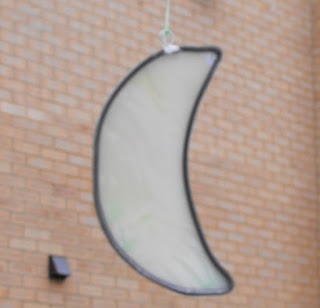One of the main reasons that leaded panels fall apart is that they aren't properly supported ....
That is an obvious statement, but in the modern age few people actually understand how a panel is held together, and it's very tempting to take things out to provide clean lines in our homes. To prevent excessive movement, any leaded light panel with a dimension over three feet (or, in a door, over two feet) must be supported with saddle bars - as per the photo below.
Saddlebars are often removed in the desire for cleaner lines, but this is always a mistake. (It is possible to co-ordinate them with the decor - with a brass sleeve, or even white plastic; and I do now recommend fixing the panel to the bars with cable ties, rather than the traditional twisted wire - which will rip dusters to pieces when you clean your windows!).
Doors, window openers, and any panel that is exposed to strong winds are particularly at risk. When new, a panel will be rigid, the glass held in place firmly by cement; over time ( thirty - eighty years) that cement dries, loses it's adhesion on the glass, and the panel becomes weaker. Eventually pieces break and have to be replaced - at which point saddle bars should be put back, and new cement spread to hold it all together again. This is a job I've had to do on a number of occasions; the photo below is actually a time when this wasn't quite the case - the breakages were caused by a broken sash cord, but saddlebars had still been taken out!
If you have a really smashing time when such a problem arises it may be better for the panel to be rebuilt with new leads - but, if only three or four lights are broken, in situ repairs may be easier.
The window in this second photo had clearly had the problem before - moct of the glass was English Muffle, but some water glass had been used as replacements (not such a good idea for a bathroom, which this was!)












